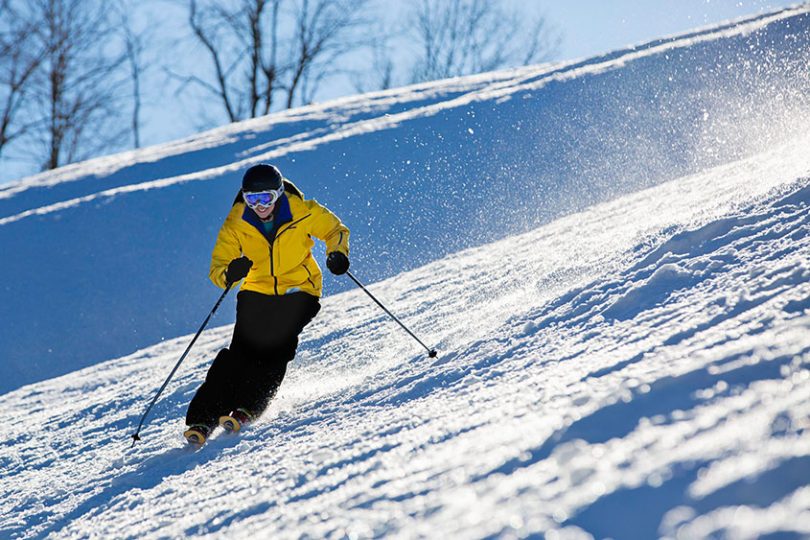Photo: wvtourism.com
Matt Laws
With the 2021-22 ski season rapidly approaching, you can hear the excitement in the air at Southeast ski resorts.
Don’t believe it? Ask Winterplace’s Tom Wagner who can hear it in his office.
“The demand is out there because our phones are ringing, and our season pass sales have been moving along,” Wagner said. “So we are very optimistic.”
The excitement in Wagner’s voice is contagious, and the longtime Winterplace fixture is just one of many—if not most—ski industry insiders in the Southeast that are at least optimistically excited with the 2021-22 season.
Rewind to this time last year, and it would be hard to fathom that anyone in any tourism industry would be excited—much less optimistic—for another season in a pandemic.
However, the resorts saw signs that things weren’t as dire as they appeared.
“When we closed down a couple of weeks early at the end of the 2020 season because of COVID, we opened for our summer season on July 4 instead of Memorial Day, and the mountain was really busy all summer,” Snowshoe Mountain Marketing and PR Manager Shawn Cassell said. “We already had kind of a sense that there’s a lot of people looking to get out and do things, especially things in the mountains where you can pretty much do as much distancing as you want. I think we had kind of a hunch that it would continue into winter.”
Cassell also noted that there were still concerns before the start of the 2020-21 season.
“With just the rules, mandates, different regulations and things like that, there were times when it was like ‘are they going to let us open for ski season,’ and so I think there were so, so many more questions than answers going in last season.”
However, it was evident early that people would still flock to the mountains as soon as the lifts started turning.
“Pretty much as soon as it started, we saw there’s still plenty of demand,” Cassell said. “I think it was out of the things you could go do—like maybe going to a movie theater, if they were open, didn’t feel like a good idea anymore but to go out into the fresh air and ski and ride on a chairlift that felt pretty safe. I think a lot of people got into skiing during the pandemic.”
When the lifts stopped spinning in March, the facts and figures told a story of an outstanding season across the board and why most are very optimistic with the 2021-22 season.
“Sugar Mountain Resort recorded its best season ever in nearly all areas,” Sugar Mountain Director of Marketing Kimberly Jochl said. “Keep in mind also, that Sugar recorded 80 inches of natural snowfall, cold temperatures much of the winter, critical for snowmaking and keeping slope conditions good and consistent, no mid-winter thaw, and a typical season of 123 skier days.”
Interestingly, the one area that was down —and was expected to be down last season— was group sales.
Massanutten Resort in Virginia found themselves in the same situation as most of the other resorts—and saw some interesting side effects.
“I think that we were just like everybody else,” Massanutten’s Kenny Hess said. “We did have some hard numbers that we capped things at, and it seemed to encourage people to ski on other days of the week. Our midweek business was up tremendously as were Fridays and Mondays and even Sundays.”
“It kind of spread the crowd out, which was a good thing, but we weren’t really sure how that was going to happen, but it did. We were happy about that.”
Snowshoe Mountain Resort was another location that had a really good season last year.
“Last season was good,” Cassell said. “It wasn’t a record-breaking season, but it was a record-breaking season in terms of midweek visitation. I would say it was definitely a top 10 season all time.”
Cassell noted that capacity limits on the weekends, the fact so many people were working remotely or doing virtual school helped drive that midweek increase.
“We’re used to having really busy weekends and kind of slow during the week,” Cassell added. “Last season, every day had this sort of just calm—consistent level of busyness.”
When Wagner reflects on what he called a good season, he points out two things that worked in the favor of the Winterplace and the Southeastern ski areas.
“One was the weather cooperated last year. We had, for the most part, average temperatures all season long which provided great skiing,” Wagner said. “The other thing is that families returned to the outdoors because it was one of the only viable options that were available last year. So, we benefited from that.”
The North Carolina High Country area may have been the biggest winners with the influx of visitors last year—with most if not all weekends looking like holidays.
“We had a challenging yet incredible season,” Beech Mountain Director of Marketing Talia Freeman said. “Skier visits were up and we certainly saw an increase in newcomers.”
Jochl echoed Wagner’s thoughts on why skiing and snowboarding were a go-to activity for many last season.
“An influx of visitors and residents to the High Country for all the reasons brought on by COVID—escape the city, flexible work schedule, perceived safe-haven in the mountain, implementation of the NCSAA Ski Well, Be Well, proactive and strict enforcement of protocols, in-person school, etc.—and as I mentioned, favorable winter weather resulted in an increase in business across the board as it relates to time and sessions,” Jochl noted.
Another welcomed event in what was a weird—and sometimes depressing—2020 news cycle was the return of the Timberline Mountain in Davis, WV, under the ownership of Perfect North. The excitement and buzz was even felt by Timberline’s neighbor Canaan Valley.
“Without question, Timberline Mountain brought a lot of excitement,” Canaan Valley Resort Marketing Manager Mark Moody said. “We joined forces in celebration of a great season and partnered on a two night “Light up the Valley” torchlight parade. It was a great success and we hope to make it an annual event.”
“Canaan Valley is home to three ski resorts —Canaan Resort, Whitegrass, and Timberline Mountain—making a perfect winter destination for snowsports enthusiasts,” Moody added. “With the success of the new Timberline Mountain, the future looks bright for all of us.”
When you fast forward to today, the resorts are preparing for another season in a pandemic—albeit a different situation than what we faced last year. That said, most resorts hope not to have the restrictions in place by their local and state governments.
That doesn’t mean, however, that the resorts will flip things back to 2019 as we adjust to a new normal.
“You know the thing is when you say go back to normal, there is a new normal that’s out there,” Wagner said when asked if things will go back to normal. “I think that’s what we are seeing and we are embracing technology and moving our business forward with regard to the way we do transactions. I think just staying contemporary with everything from Starbucks to Amazon—those advanced purchases or that personal cash register you have in your hand is going to be utilized a lot more.”
The technology trend, especially when it comes to advanced sales and lift tickets, will be one pandemic trend most resorts will continue to adapt and adjust to further the consumer experience.
“You know the advanced ticket sales and all online sales, it forced everybody in the industry into moving in that direction, and we will continue that trend,” Hess said. “Right now, we don’t anticipate any capacity limits, but we’re planning like that so that it is easier to roll them in as opposed to acting like nothing’s going to happen and then being surprised by it. It is easier to reduce the restrictions than it is to add them.”
Massanutten is also adding RFID gates this season which will allow skiers and riders to reload their cards and go directly from the parking lot to the lift.
The resort outside of Harrisonburg is the latest resort to join the RFID trend with West Virginia’s Timberline Resort, Wisp Resort in Maryland and Virginia’s Wintergreen also joining the trend in the last year.
“It is a growing trend,” Hess said. “The ski industry has been lacking in adopting technology for years, and I think that COVID kind of sped up that process and we are excited about the things that we will be able to provide.”
Social media also became at the forefront for most resorts to update skiers, snowboarders, and other visitors. For some, they contribute midweek success to the wealth of information.
“We definitely experienced something similar at Canaan,” Moody said of the midweek increase. “I think this was partly from us providing updates via email and social media to our guests and prospective guests as best we could. This consisted of providing info on snowmaking, snowfall, weather, what trails were open, as well as any new events or specials we had going on.”
Other resorts echoed the statements of taking lessons learned from the 2020-21 season and putting them to good use.
“Sugar will continue to approach the future with the knowledge gained and lessons learned from the past and with the evolving technology intended to optimize the customer experience,” Jochl said.
The Omni Homestead Resort had been using online tickets before COVID-19 was a thought, that doesn’t mean they aren’t going to finetune their system.
Omni Homestead had an excellent season —including a measurable increase on Thursdays and Sundays.
The digital trend has been a way of life on Beech Mountain for some time, and there will be no going back for the North Carolina resort.
“We have been offering this for several years,” Freeman said of digital ticketing. “I think more customers expect this now and I don’t think going back is an option. It is helpful to us for forecasting and helps streamline the customer experience.”
“As a part of our dedication to a sustainable future, we are working towards becoming completely paperless. We have moved to a digital waiver system and a digital rental equipment agreement system.”
One additional area technology that became prominent for some resorts in the 2020-21 season was food and beverage service inside the lodges.
“Indoor capacity restrictions were particularly challenging for food and beverage outlets (last season),” Lori Zaloga—Director of Marketing for PGRI East Coast Resorts including Wisp Resort and Wintergreen Resort—said. “However one bright spot was the addition of online food ordering through our mobile apps introduced at both resorts which was well-received by guests and our food and beverage teams.”
As Wisp Resort and Wintergreen Resort get ready for the 2021-22 season, the strategy isn’t going to change all that much—if any— due to the improvement of the on-snow experience.
“By limiting lift ticket capacity, particularly on weekends, we created a better on-snow guest experience, and mountain operations teams were able to anticipate business levels to staff and serve our guests accordingly,” Zaloga said. “We don’t anticipate changing this strategy for the 2021-22 winter season.”
Snowshoe is still nailing things down for the upcoming season as far as mask requirements and other regulations, but the capacity limits will stay in place – with the percentage still to be determined.
“We do plan on keeping capacity limits in place, and I think that was going to be the plan even if we had already kicked COVID,” Cassell said. “I think that was something that we had much better feedback from our guests —especially our weekend guests last season —as opposed to the two winters before that. It just seemed like people were having a better experience overall.”
“I think we’ve learned a lot of things that have made improvements across the board for the visitor experience,” Wagner said. “I think we are going to embrace those and continue to move forward so we are going to continue to evolve.”
Matt Laws writes for Ski Southeast







